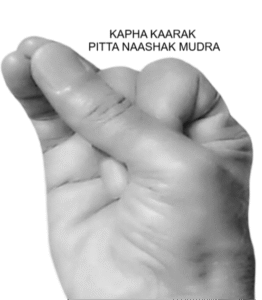Kapha Kaarak Pitta Naashak Mudra
Introduction
In yogic mudra therapy, specific hand gestures are practiced to balance the three doshas (Vata, Pitta, and Kapha) as described in Ayurveda. The Kapha Kaarak Pitta Naashak Mudra is a therapeutic gesture that increases Kapha dosha (which governs structure, stability, water, and earth elements) and reduces Pitta dosha (which governs fire and metabolism). This mudra is especially beneficial for people suffering from excess Pitta conditions such as hyperacidity, inflammation, irritability, and excessive heat in the body.
Meaning
Kapha = Earth + Water (structure, lubrication, immunity).
Kaarak = enhancing or increasing.
Pitta = Fire + Water (digestion, metabolism, heat, transformation).
Naashak = destroyer or reducer.
Thus, this mudra literally means the gesture that increases Kapha and decreases Pitta, restoring doshic balance in favor of coolness, calmness, and stability.
How to Perform (Method of Practice)
Step-by-Step:
Sit in Sukhasana, Padmasana, or any meditative posture with spine erect.
Relax shoulders, close eyes, and breathe naturally.
Fold the index and middle finger towards inner palm.
Then joining together the tips of the thumb, the ring finger and the little Finger.
Rest the hands on the knees with palms facing upward.
Practice slow, deep abdominal breathing while maintaining awareness of coolness and stability.
Benefits
Physical Benefits
Reduces Pitta disorders like acidity, gastritis, burning sensation, ulcers, and skin rashes.
Promotes cooling effect in the body.
Enhances Kapha qualities like stability, lubrication, and immunity.
Helps in cases of dryness, fatigue, and tissue depletion due to excess heat.
Supports better sleep by reducing hyperactivity.
Mental & Emotional Benefits
Calms anger, irritability, and aggression (Pitta emotions).
Enhances patience, stability, and compassion (Kapha qualities).
Reduces overthinking and excessive drive.
Spiritual Benefits
Balances Manipura (solar plexus chakra) by cooling excessive fire energy.
Enhances grounding and inner calmness.
Contraindications
Should be avoided in cases of Kapha aggravation (cold, cough, congestion, obesity, lethargy).
Not suitable for people with low digestion power (Mandagni) if Kapha is already high.
Should not be practiced for very long in humid or cold climates.
Anatomy & Physiology
Fingers involved:
Little finger → water element.
Ring finger → earth element.
Thumb → fire element.
By touching water + earth with fire, the excess fire of Pitta is suppressed, and the Kapha qualities are enhanced.
Physiologically, it reduces hyperacidity, balances liver and gallbladder ativity, and supports hydration and tissue stability.
Kinesiology
Involves flexion of ring and little fingers to meet the thumb.
Stabilizes fine motor coordination in the hand.
Encourages balance between flexor and extensor muscles of the palm.
Neurology
Stimulates the ulnar nerve (ring and little finger areas).
Calms the sympathetic nervous system by reducing Pitta-driven stress.
Activates parasympathetic response, which cools the body and mind.
Duration of Practice
Therapeutic use: 15–20 minutes, 2–3 times daily.
For chronic Pitta imbalance: Up to 45 minutes daily (divided sessions).
For meditation: Can be held throughout the sitting practice.
Best practiced during noon or evening when Pitta dosha is naturally high.
Counter Mudra
Surya Mudra (Agni Vardhak Mudra): Opposite mudra that increases Pitta/fire.
Varun Mudra: Balances water element without increasing earth.
Vayu Mudra: For balancing excess Kapha if it rises due to overuse of this mudra.
Conclusion
The Kapha Kaarak Pitta Naashak Mudra is a dosha-balancing yogic hand gesture that reduces excess heat, inflammation, and irritability caused by aggravated Pitta while simultaneously enhancing Kapha qualities such as stability, calmness, and lubrication. When practiced regularly, it helps restore harmony between fire and water/earth energies, offering cooling, grounding, and healing benefits for both body and mind.
FAQ
Q1: Who should practice this mudra?
Anyone with Pitta imbalance (acidity, anger, skin rashes, heat-related issues).
Q2: Can it be practiced daily?
Yes, but avoid long-term daily use if Kapha is already dominant in your body.
Q3: What is the best time to practice?
During Pitta hours (10 AM–2 PM and 10 PM–2 AM).
Q4: Can it help with stress?
Yes, it reduces anger, irritability, and excessive drive, bringing calmness.
Q5: Can children practice it?
Yes, for short durations (5–10 minutes) under guidance.
References
Swami Satyananda Saraswati – Asana, Pranayama, Mudra, Bandha.
Gertrud Hirschi – Mudras: Yoga in Your Hands.
Dr. Vasant Lad – Ayurveda: Science of Self-Healing.
Swami Niranjanananda Saraswati – Yoga Darshan.
Ayurvedic research papers on dosha-balancing mudra therapy.

